The Global Nematicides Market size is projected to reach US$ 3.84 billion by 2031 from US$ 2.01 billion in 2024. The market is expected to register a CAGR of 9.8% during 2025–2031.
Global Nematicides Market Analysis
The nematicides market is witnessing steady growth, driven by increasing crop losses due to nematode infestations and rising demand for food security. Farmers are adopting nematicides to enhance crop yield and protect soil health. The awareness of integrated pest management (IPM) practices supports using safer, more targeted solutions. This demand is bolstered by innovations in bio-based nematicides, presenting an opportunity for sustainable agriculture. As environmental concerns and regulatory pressures rise, the shift toward eco-friendly and efficient alternatives positions the market for expansion, especially in developing agricultural economies with untapped potential.
Global Nematicides Market Overview
Nematicides are chemical and biological products that control nematodes, microscopic pests that damage crops and reduce agricultural productivity. The need for effective pest control solutions has grown with increasing global food demand and shrinking arable land. Nematicides protect high-value crops such as vegetables, fruits, and cereals. The market includes synthetic and bio-based products, with a notable shift toward environmentally friendly alternatives due to regulatory restrictions and sustainability goals. Key players invest in R&D to develop safer, more efficient solutions, driving innovation and growth across developed and emerging agricultural regions.
Customize This Report To Suit Your Requirement
You will get customization on any report - free of charge - including parts of this report, or country-level analysis, Excel Data pack, as well as avail great offers and discounts for start-ups & universities
Nematicides Market: Strategic Insights
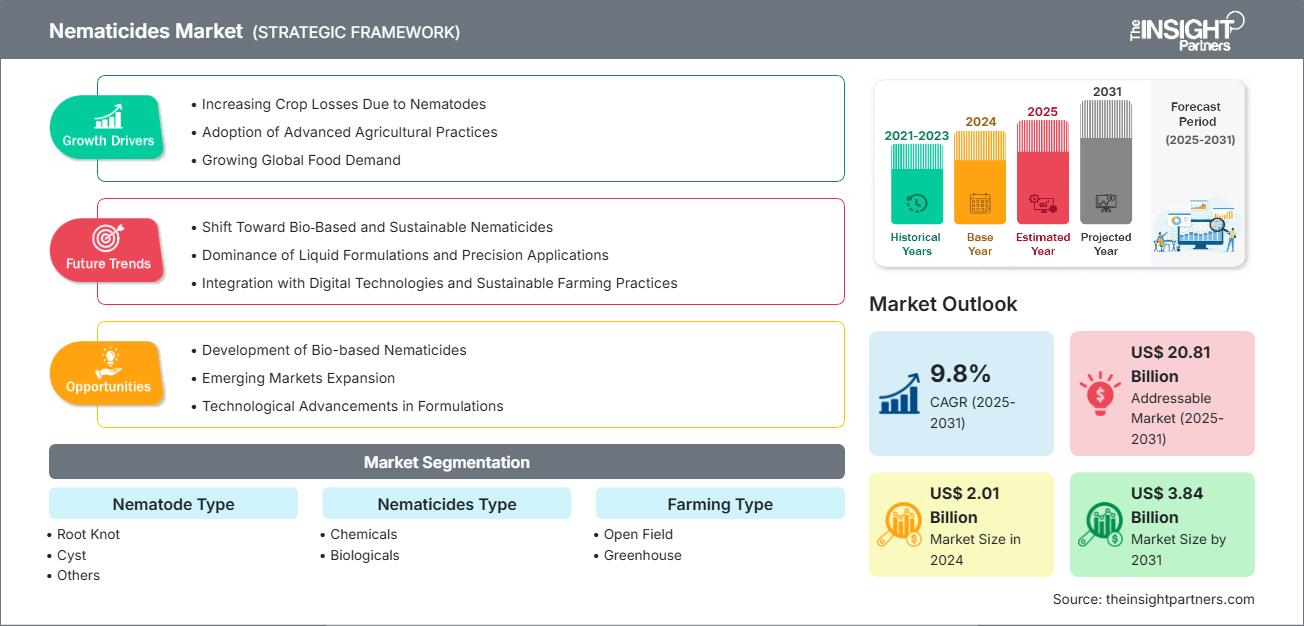
-
Get Top Key Market Trends of this report.This FREE sample will include data analysis, ranging from market trends to estimates and forecasts.
Global Nematicides Market Drivers and Opportunities
Market Drivers:
- Increasing Crop Losses Due to Nematodes Rising crop damage caused by nematodes is pushing farmers to adopt nematicide solutions.
- Growing Global Food Demand The need to boost agricultural productivity to feed a growing population fuels nematicide use.
- Adoption of Advanced Agricultural Practices Modern farming techniques encourage integrated pest management, including the use of nematicides.
- Expansion of High-Value Crop Cultivation Farmers invest in high-value crops such as fruits and vegetables, which require protection from nematodes.
- Soil Health Awareness Farmers are more aware of the importance of nematode control in maintaining long-term soil fertility.
- Government Support and Subsidies Governments support pesticide use through subsidies or extension services to improve yields.
Market Opportunities:
- Development of Bio-based Nematicides Rising demand for eco-friendly solutions opens doors for natural and organic nematicides.
- Emerging Markets Expansion Countries in the Asia Pacific, Latin America, and Africa offer growth potential due to large agricultural bases.
- Precision Agriculture Integration The use of data-driven farming can enhance targeted nematicide application and improve efficiency.
- Regulatory Push for Safer Products Bans on hazardous chemicals create a gap for innovative, safer nematicide products.
- Technological Advancements in Formulations Innovations in delivery mechanisms (e.g., microencapsulation) improve product effectiveness and reduce environmental impact.
Global Nematicides Market Report Segmentation Analysis
The global nematicides market is divided into different segments to give a clearer view of how it works, its growth potential, and the latest trends. Below is the standard segmentation approach used in industry reports:
By Nematode Type:
- Root Knot The root knot nematicide segment dominates due to the widespread presence of Meloidogyne species affecting crops globally.
- Cyst Cyst nematodes are in demand as they protect cereals and legumes from yield losses caused by Heterodera and Globodera species.
- Others This segment includes products targeting lesser-known nematode species, gaining traction with improved diagnostics and crop-specific treatments.
By Nematicides Type:
- Chemical Chemical nematicides remain widely used for their fast-acting and broad-spectrum control of nematode infestations.
- Biologicals Biological nematicides are gaining momentum as eco-friendly alternatives, driven by regulatory pressures and sustainability trends.
By Mode Application:
- Fumigation Fumigation nematicides are widely used due to their rapid and broad-spectrum control of soil-borne nematodes before planting.
- Seed Treatment Nematicides protect seeds and seedlings from early nematode attacks, ensuring healthy crop establishment.
- Soil Treatment Soil treatment nematicides target nematodes in the soil to prevent infestation throughout the growing season.
- Others This category includes foliar and drip irrigation nematicides, offering specialized application methods for targeted pest control.
By Farming Type:
- Open Field Open field nematicides are used in large-scale farming to protect staple and cash crops from nematode damage.
- Greenhouse Greenhouse nematicides are critical for controlled environment agriculture, ensuring high-value plants remain nematode-free.
By Crop Type:
-
Fruits and Vegetables
In fruits and vegetables, Nematicides protect delicate root systems and ensure high-quality yields.
-
Potato
Nematicides protect potatoes from yield losses caused by root-knot and lesion nematodes. - Carrots Targeted nematicides help maintain carrot quality by controlling soil nematodes.
- Strawberries Nematicides are crucial in strawberries to prevent nematode-induced root damage in high-value production.
- Others Includes diverse fruits and vegetables benefiting from nematicide protection against nematode species.
-
-
Grains and Cereals
Nematicides help safeguard staple grains and cereals from nematode infestations, securing the global food supply.
-
Wheat
Nematicides safeguard wheat crops from cyst and root lesion nematodes, improving yield stability. - Maize Maize production relies on nematicides to manage nematode infestations affecting root systems.
- Rice Rice cultivation utilizes nematicides to combat nematodes in flooded and upland fields.
- Barley Nematicides help protect barley from yield losses due to soil nematodes.
- Sorghum Sorghum growers use nematicides to reduce nematode pressure in arid regions.
- Others Includes other cereals where nematicides minimize nematode-related crop damage.
-
-
Pulses and Oilseeds
Pulses and oilseeds benefit from nematicides that reduce root damage and improve crop productivity.
-
Soybean
Nematicides protect soybeans from root-knot nematode damage. - Sunflower Nematicides improve sunflower crop health by controlling soil nematode populations.
- Beans Beans benefit from nematicide use to prevent nematode-induced root damage and yield loss.
- Canola Nematicides support canola production by mitigating nematode infestations in soil.
- Others Covers other pulses and oilseeds where nematicides help maintain crop productivity.
-
- Others This segment includes other crops and horticultural plants benefiting from nematicide applications to control nematode species.
By Geography:
- North America
- Europe
- Asia Pacific
- Middle East and Africa
- South and Central America
The regional trends and factors influencing the Nematicides Market throughout the forecast period have been thoroughly explained by the analysts at The Insight Partners. This section also discusses Nematicides Market segments and geography across North America, Europe, Asia Pacific, Middle East and Africa, and South and Central America.
Nematicides Market Report Scope
| Report Attribute | Details |
|---|---|
| Market size in 2024 | US$ 2.01 Billion |
| Market Size by 2031 | US$ 3.84 Billion |
| Global CAGR (2025 - 2031) | 9.8% |
| Historical Data | 2021-2023 |
| Forecast period | 2025-2031 |
| Segments Covered |
By Nematode Type
|
| Regions and Countries Covered |
North America
|
| Market leaders and key company profiles |
|
Nematicides Market Players Density: Understanding Its Impact on Business Dynamics
The Nematicides Market is growing rapidly, driven by increasing end-user demand due to factors such as evolving consumer preferences, technological advancements, and greater awareness of the product's benefits. As demand rises, businesses are expanding their offerings, innovating to meet consumer needs, and capitalizing on emerging trends, which further fuels market growth.
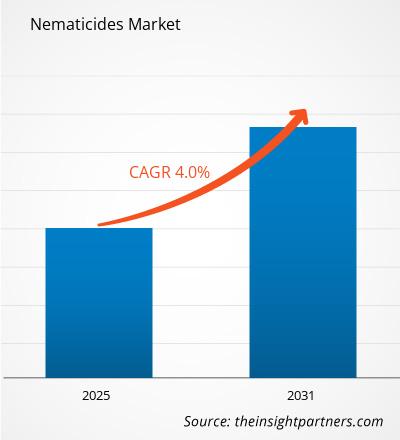
- Get the Nematicides Market top key players overview
Global Nematicides Market Share Analysis by Geography
The nematicides market in the Asia Pacific is witnessing the fastest growth, driven by the rising crop losses from nematodes, growing global food demand, expansion of high-value crop cultivation, and government support and regulations.
The nematicides market growth differs in each region due to increasing incidence of nematode infestations, growing global food demand, expansion of high-value crop production, advancements in nematicide formulations, government initiatives and subsidies, and adoption of Integrated Pest Management (IPM). Below is a summary of market share and trends by region:
1. North America
- Market Share: Moderate share with growing emphasis on sustainable and precision agriculture
-
Key Drivers:
- Increasing adoption of IPM practices
- Rising demand for high-value crops such as fruits and vegetables
- Government support for eco-friendly pest control products
- Trends: Growing use of bio-based nematicides and advanced application technologies
2. Europe
- Market Share: Significant share driven by strict environmental regulations and sustainable farming initiatives
-
Key Drivers:
- Regulatory push for reduced chemical pesticide use
- Expansion of organic farming and bio-nematicides
- Strong focus on soil health and sustainable agriculture
- Trends: Shift toward safer, environmentally friendly nematicides and integrated crop protection solutions
3. Asia Pacific
- Market Share: Largest and fastest-growing due to vast agricultural activities and rising food demand
-
Key Drivers:
- Increasing demand for food security and high crop yields
- Government initiatives to modernize agriculture and reduce chemical pesticide use
- Awareness of the environmental and health impacts of synthetic pesticides
- Trends: Adoption of precision farming tools and bio-based pest control solutions
4. Middle East and Africa
- Market Share: Smaller but gradually growing market focused on improving crop productivity
-
Key Drivers:
- Need to enhance food security in arid and semi-arid regions
- Government incentives for sustainable farming and water-efficient practices
- Investments in agricultural infrastructure and technology
- Trends: Introduction of drought-tolerant crops and bio-based pest control methods
5. South and Central America
- Market Share: Emerging market with growth potential driven by significant agricultural exports
-
Key Drivers:
- Expansion of export-oriented farming sectors such as coffee, soy, and fruits
- Increasing use of integrated pest management practices
- Support from international organizations for sustainable agriculture
- Trends: Introduction of drought-tolerant crops and bio-based pest control methods
Global Nematicides Market Players Density: Understanding Its Impact on Business Dynamics
High Market Density and Competition
Competition is intense due to the presence of established players such as Bayer AG, BASF SE, Syngenta AG, FMC Corp, UPL Ltd, and Corteva Inc. Regional and niche providers such as American Vanguard Corporation, VIVE CROP PROTECTION, ISHIHARA SANGYO KAISHA LTD, Valent Biosciences LLC, and Pro Farm Group add to the competitive landscape across different regions.
This high level of competition urges companies to stand out by offering:
- Highly effective nematode control solution
- Eco-friendly and sustainable formulations
- Competitive pricing models
- Innovative delivery and application technologies
Opportunities and Strategic Moves
- Rising Demand for High-Value Crops.
- Shift Toward Bio-based Nematicides.
- Resistance Management Needs
- Enhance Farmer Training & Support
- Expand Product Portfolio
Major Companies operating in the Global Nematicides Market are:
- Bayer AG
- BASF SE
- Syngenta AG
- FMC Corp
- UPL Ltd
- Corteva Inc
- Nufarm
- ADAMA LTD
- Certis USA LLC
- American Vanguard Corporation
Disclaimer: The companies listed above are not ranked in any particular order.
Other companies analyzed during the course of research:
- VIVE CROP PROTECTION
- ISHIHARA SANGYO KAISHA LTD
- Valent Biosciences LLC
- Pro Farm Group
- T.Stanes and Company Limited
- Sumitomo Chemical Co Ltd
- Horizon Group
- Varsha Bioscience and Technology India Private Limited
- Telluris Biotech India Private Limited
- Valent BioSciences LLC
- CERTIS Biologicals
- Bio Huma Netics, Inc
- Pheronym
- Real IPM Kenya
- Crop IQ Technology Ltd
- Ecowin
Global Nematicides Market News and Recent Developments
- Corteva Agriscience introduced an innovative solution called Reklemel active to combat plant-parasitic nematodes Corteva Agriscience introduced an innovative solution called Reklemel active to combat plant-parasitic nematodes, tiny soil-dwelling organisms that harm plant roots. These nematodes significantly challenge global food security, causing annual damages exceeding US$ 80 billion. Reklemel active, the result of over a decade of research and investment by Corteva, aims to protect food and row crops from nematode damage while preserving the soil's beneficial organisms.
- Syngenta's TYMIRIUM technology received regulatory approval in Argentina. Syngenta's TYMIRIUM technology received regulatory approval in Argentina, bringing farmers closer to accessing the novel, highly effective nematicide and fungicide for seed and soil use, even at low rates. TYMIRIUM® technology provides long-lasting protection against invisible yet highly destructive nematodes and soil-borne diseases – particularly the Fusarium species. Key benefits include its ability to safeguard plant roots from attack, translocate to above-ground parts of the plant, and protect against early-season diseases. Simple to apply, it is highly compatible with other crop inputs. Farmers using TYMIRIUM® technology benefit from its ability to preserve soil biodiversity and health. A protected, stronger root system supports soil structure and organic matter, enhances nutrient use efficiency, and improves crop resilience to biotic and abiotic stress. Highly selective, TYMIRIUM® technology has minimal impact on beneficial insects, pollinators, and soil biodiversity.
Global Nematicides Market Report Coverage and Deliverables
The " Global Nematicides Market Size and Forecast (2021–2031)" report provides a detailed analysis of the market covering the following areas:
- Global Nematicides Market size and forecast at global, regional, and country levels for all the key market segments covered under the scope
- Global Nematicides Market trends, as well as market dynamics such as drivers, restraints, and key opportunities
- Detailed Porters and SWOT analysis
- Global Nematicides Market analysis covering key market trends, global and regional framework, major players, regulations, and recent market developments
- Industry landscape and competition analysis covering market concentration, heat map analysis, prominent players, and recent developments for the Global Nematicides Market
- Detailed company profiles
Frequently Asked Questions
Which region dominated the nematicides market in 2024?
What are the emerging trends in the nematicides market?
Which are the major players operating in the nematicides market?
What are the factors driving the Nematicides' market growth?
What would be the estimated value of the nematicides market by 2031?
- Historical Analysis (2 Years), Base Year, Forecast (7 Years) with CAGR
- PEST and SWOT Analysis
- Market Size Value / Volume - Global, Regional, Country
- Industry and Competitive Landscape
- Excel Dataset
Recent Reports
Testimonials
Reason to Buy
- Informed Decision-Making
- Understanding Market Dynamics
- Competitive Analysis
- Identifying Emerging Markets
- Customer Insights
- Market Forecasts
- Risk Mitigation
- Boosting Operational Efficiency
- Strategic Planning
- Investment Justification
- Tracking Industry Innovations
- Aligning with Regulatory Trends












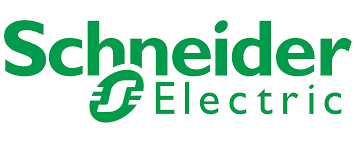


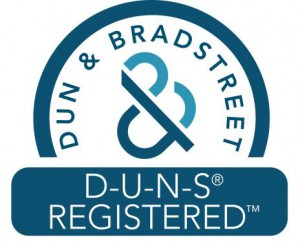
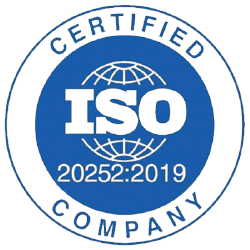
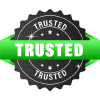



 Get Free Sample For
Get Free Sample For